Historic Boulder fights to save iconic buildings from demolition
August 14, 2024 | Boulder, Boulder County, Colorado
This article was created by AI summarizing key points discussed. AI makes mistakes, so for full details and context, please refer to the video of the full meeting. Please report any errors so we can fix them. Report an error »

During a recent government meeting, representatives from Historic Boulder voiced their concerns regarding the management and processes of the Landmarks Board. Leonard Siegel emphasized the importance of maintaining the current structure of the board, which consists of two members and one staff person for design review meetings. He argued that this configuration enhances the quality of discussions and decision-making, particularly in light of the increasing volume of demolition permits expected in the future.
Siegel cautioned against reducing the number of meetings, suggesting that such a move could hinder the board's ability to effectively manage its workload. He also highlighted the need to consider the timing of meetings, advocating for a schedule that supports staff availability and acknowledges the diverse demographics of the community.
In addition to procedural concerns, Siegel raised specific preservation issues, including the potential demolition of Mustard's Last Stand, a building dating back to 1955, and a credit union building designed by notable architect Hobart Wagner. He urged the board to consider supporting preservation efforts for these structures as part of ongoing civic center redesign discussions.
The meeting also featured passionate remarks from Lynn Siegel, who criticized recent alterations made to a historic building at 1105 Spruce. Expressing her outrage, she described the changes as \"horrific\" and called for a reevaluation of the guidelines governing the Landmarks Board's decisions. Lynn Siegel's comments underscored a growing frustration among community members regarding the preservation of Boulder’s architectural heritage.
The discussions reflect a broader concern about balancing development with the preservation of the city’s historical character, as stakeholders continue to navigate the complexities of urban planning and community identity.
Siegel cautioned against reducing the number of meetings, suggesting that such a move could hinder the board's ability to effectively manage its workload. He also highlighted the need to consider the timing of meetings, advocating for a schedule that supports staff availability and acknowledges the diverse demographics of the community.
In addition to procedural concerns, Siegel raised specific preservation issues, including the potential demolition of Mustard's Last Stand, a building dating back to 1955, and a credit union building designed by notable architect Hobart Wagner. He urged the board to consider supporting preservation efforts for these structures as part of ongoing civic center redesign discussions.
The meeting also featured passionate remarks from Lynn Siegel, who criticized recent alterations made to a historic building at 1105 Spruce. Expressing her outrage, she described the changes as \"horrific\" and called for a reevaluation of the guidelines governing the Landmarks Board's decisions. Lynn Siegel's comments underscored a growing frustration among community members regarding the preservation of Boulder’s architectural heritage.
The discussions reflect a broader concern about balancing development with the preservation of the city’s historical character, as stakeholders continue to navigate the complexities of urban planning and community identity.
View full meeting
This article is based on a recent meeting—watch the full video and explore the complete transcript for deeper insights into the discussion.
View full meeting
